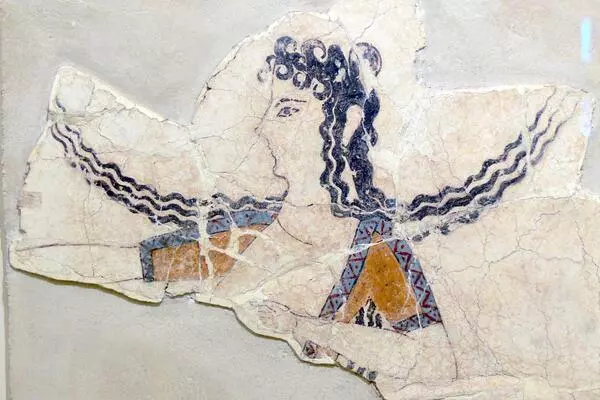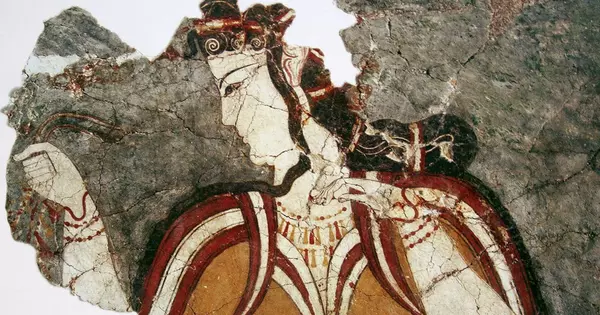Archaeologists from the University of Cincinnati discovered, using new scientific tools, that an ancient Greek leader known today as the Griffin Warrior grew up near the seaside city he would one day rule. The findings are part of three new studies published in the journal Science that looked at the ancient DNA of the Griffin Warrior and 726 other people who lived before and during the Bronze Age to learn more about their origins and movements across three continents surrounding the Mediterranean Sea.
The papers, led by Harvard University researchers and co-authored by experts from around the world, show that between 5,000 and 7,000 years ago, people with Caucasus ancestry moved west into Anatolia (now Turkey) and north into the steppe of Eastern Europe. Then, around 5,000 years ago, people from Eastern Europe spread across the European continent, into Western Asia, and back to the Caucasus. They mixed with local populations, “creating a tapestry of diverse ancestry from which speakers of the Greek, Paleo-Balkan, and Albanian languages arose.”
“When we look at the rise of Mycenaean civilization, the ancient DNA supports the notion that it was a local phenomenon, not something imported from the outside,” said co-author Jack Davis, a UC Classics professor, and department head. “The development of the state by the Mycenaean was indigenous to Greece,” Davis said.
The Griffin Warrior’s tomb, discovered in 2015 by Davis and UC Classics senior research associate Sharon Stocker, was among the remains studied for ancient DNA analysis.
Davis and Stocker discovered the tomb in Pylos, a coastal city in southern Greece, beneath an olive grove. A forensic examination revealed that the remains belonged to a young man between the ages of 30 and 35 from a wealthy family. His tomb was filled with weapons, armor, and valuable artwork, including an ivory plaque depicting the mythological half-eagle, half-lion griffin that gave the warrior his nickname.
This type of research is critical for our understanding of the region’s ancient history and the role of the Mycenaeans in shaping that history. Mycenaean tombs are difficult to study because their mortuary rituals involved skeleton repositioning when newer interments took place in tombs that had been used for generations.
Schepartz
“We were interested in the local implications for our interpretation of what we found at Pylos but also within the broader Mycenaean civilization,” Davis said.
Archaeology magazine heralded the UC Classics’ project as the greatest archaeological discovery in Greece in the past 50 years. Their revelations continued UC’s storied tradition of exploration in Greece. Previously at Pylos, UC Classics professor Carl Blegen and his Greek colleague, Konstantinos Kourouniotis, unearthed the Palace of King Nestor, a figure mentioned by Homer in his epic poems.
While working on the Griffin Warrior, Davis and Stocker discovered two nearby gold-covered tholos, or beehive-shaped family tombs, in 2018. The tholos tombs, like the Griffin Warrior’s tomb, were filled with cultural artifacts and exquisite jewelry.
Davis and Stocker enlisted the help of former UC anthropology professor Lynne Schepartz, who is now at the University of Arizona, to reconstruct the warrior’s features in 2016. Additional research using ancient DNA is now filling in the blanks about the Griffin Warrior’s life in Greece 3,500 years ago.
“He was a young man, and wealthy, who served different functions: a religious or sacred function, as an outstanding warrior and as leader of his people,” Stocker said. “He was one of the first kings of Mycenaean Pylos. Until then there had been competing aristocratic families, which explains why there were multiple tholos tombs,” Stocker said. “But the Griffin Warrior was one of the first individuals to unite all of these functions within society.”
Stocker supervised the excavations of the Griffin Warrior and tholos tombs.

“This research addresses a bigger question about population dynamics. Where did the Greeks come from? We had no way of addressing that question without looking at genetic relationships,” Davis said. For the ancient DNA analysis, Davis and Stocker again turned to Schepartz to examine remains.
“Mycenaean tombs are difficult to study because their mortuary rituals involved skeleton repositioning when newer interments took place in tombs that had been used for generations,” Schepartz explained. Schepartz, a co-author of the Science articles, collected DNA samples from the Griffin Warrior’s petrous bone, a part of the skull near the inner ear that frequently preserves ancient DNA.
Ancient DNA is a powerful tool for researchers because it can reveal how people are related to one another and where they lived. UC researchers used ancient DNA to learn more about the ancient Maya agricultural practices in Mexico’s Yucatan Peninsula.
“This type of research is critical for our understanding of the region’s ancient history and the role of the Mycenaeans in shaping that history,” Schepartz said. Schepartz discovered that the two tholos tombs and seven chamber tombs discovered by Blegen at the Palace of Nestor contained more people than researchers had previously thought.
Schepartz used isotopic analysis on the samples to learn more about the diets of the ancient Greeks at Pylos. She discovered that men consumed more protein than women. People interred in tholos tombs consumed more protein than those interred in chamber tombs. High-protein diets are regarded as a barometer of good nutrition, which frequently correlates with social standing or wealth.
These findings correspond with what we know about ancient Greek rituals, she said.
“For example, the participation of males at feasts where meat was consumed is documented, but the participation of females may have been much less frequent,” she said. “For us, we’re really interested in the relationships between the people buried in the tombs at Pylos and the wider population,” Stocker said. “Ancient DNA is the only way to establish these relationships.”
Ancient DNA also supports what UC’s experts have suspected all along: the Griffin Warrior was from the region he would later rule. Davis said the new evidence refutes the suggestion that he was an invader or outsider.
“We’ve always been skeptical about that theory but weren’t able to prove it except through DNA analysis,” Davis said. UC’s contribution to the study was made possible in part by Blegen, the former department head of UC Classics, who had the foresight to preserve samples. In Turkey, Blegen showed that Homer’s Iliad was based on historical events, including the sack of Troy during the Trojan War.
“Blegen was ahead of his time in recognizing that better technology would be available in the future,” Stocker said. “He saved all of the human and animal remains from his excavation, so we were able to go back and collect DNA samples from him.”
Similarly, Stocker stated that her team has taken steps to preserve excavated material at its sites for future archaeologists who will likely have access to advanced equipment or techniques. When it comes to anthropological surveys, ancient DNA analysis, according to Stocker, is still in its infancy. For statistical interpretation, sample sizes are currently very small. But she is ecstatic about the direction of the research.





